For the hardest working room in the house, it’s essential that it’s properly lit to handle all the activities that take place there—prepping food, cooking, entertaining, and dining, among others. The kitchen is also a place to inject some personal style and even some whimsy to keep the space from feeling too serious. We asked designers to weigh in with their advice on kitchen lighting and to share some of their favorite tried-and-true styles.
START WITH THE ARCHITECTURE

Photo by Michael Lucas Photography
Nantucket-based Melanie Gowen put together a cottage feel in this small kitchen with open shelving and a pair of blue-and-white pendant lights over the island. Lighting: Serena & Lily.
Your home’s architecture should be taken into account when planning lighting for the kitchen, as Nantucket designer Melanie Gowen explains. “The ceiling height and ceiling shape will dictate how you will be able to adequately light the kitchen. A cathedral ceiling will require different lumens and beam spreads than a flat ceiling,” she says. “Look for architectural lighting opportunities in addition to task and direct lighting. If beams run across the ceiling, these could be an opportunity to recess hidden tape lighting or incorporate track or mono-point fixtures. In all cases, make the architectural lighting as discreet as possible through selecting fixtures and components in finishes that will blend into the space.”
Washington, D.C., designer Andrea Houck has this advice: “We always consider the architectural style of the house. We tend to prefer that the exterior and interior of a home speak the same design language,” she says. “But that’s not to say that we don’t occasionally like to mix things up a bit. Depending on our goals, we might hang a modern acrylic lantern, for instance, within a traditional Colonial. The important point is that lighting shouldn’t be an afterthought. Lighting deserves careful consideration and should be an integral part of the design plan from the get-go.
If you are blessed with an outstanding detail in a space, you certainly want to draw attention to it, as Atlanta, Georgia designer Beth Meyer shares. “I had a kitchen that was vaulted with trusses out of reclaimed beams which we certainly wanted to highlight. We had to address lighting the ceiling as well as the working spaces.”

Photo by Robert Peterson of Rustic White
Beth Meyer designed this kitchen with a wall sconce that provides workspace light and uplighting to highlight the wooden ceiling. Lighting by Noire Furniture.
NATURAL LIGHT

Photo by Aaron Dougherty
This Trish Sheats-designed kitchen is filled with natural light from windows between the countertops and upper cabinets. A pair of gold lanterns lights the island. Lighting by Visual Comfort.
Hello sunshine! “Natural light plays a very important role in the design of kitchens,” says Lisa Davenport of LLD Designs. “Ideally, I like to incorporate a lot of natural light. Nothing is more inviting than pouring a morning cup of coffee while a warm ray of sunlight kisses your face.”
Adds designer Layton Campbell, “It is a good practice to experience the natural light your kitchen receives at different times throughout the day. This will guide you in how to light the space. If you’re building, examine where and when the sun will be hitting your kitchen. Make sure you pay attention to areas that are ‘dark spots’ in your kitchen. You want the light to be evenly dispersed.”
Washington, D.C., designer Andrea Houck shares this advice: “The orientation of the home and its existing natural light—or lack thereof—might impact our choices. For example, if a room faces north and sunlight is limited, then we will increase the ambient lighting and add a few more recessed lights. The home’s location factors into the equation, as well. A beach house, obviously, requires a different approach than a city condominium.”
LAYERING KITCHEN LIGHTING
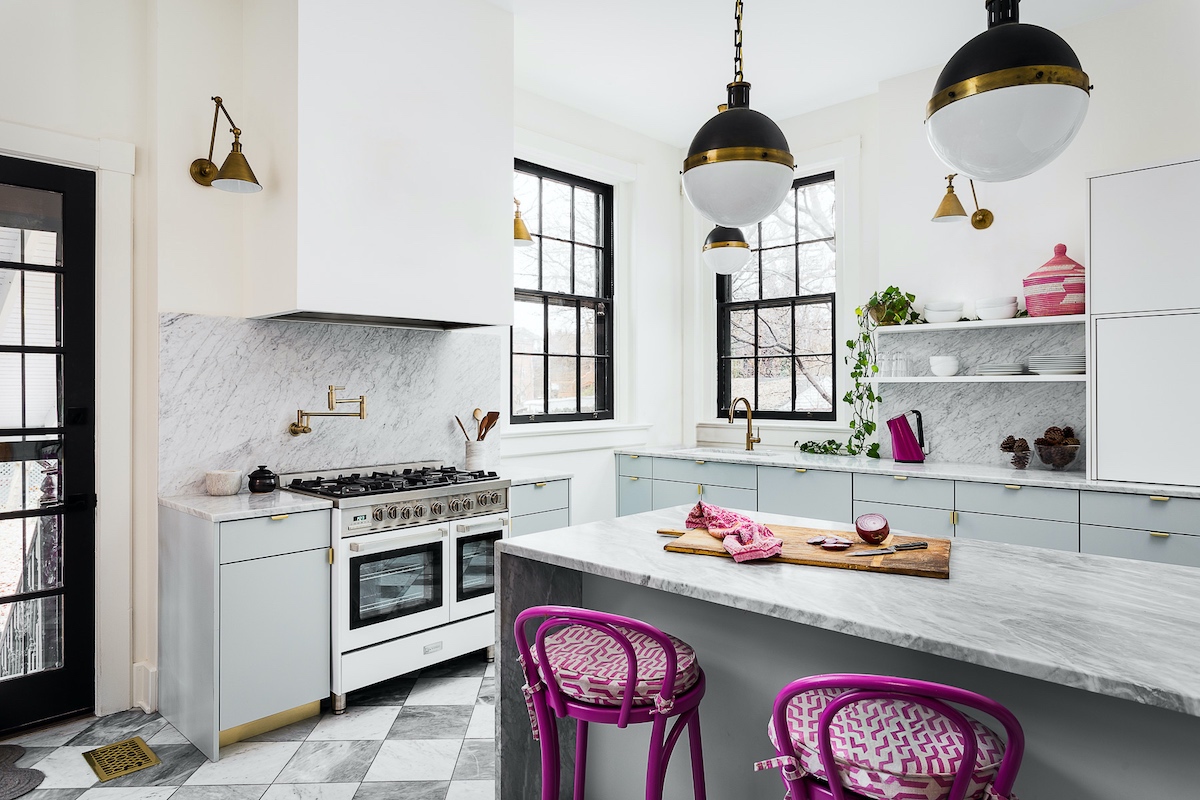
Photo by J. L. Jordan Photography
Bethany Adams layers lighting beautifully with pendants over the island and sink, and brass sconces over cabinet countertops. Lighting by Visual Comfort.
Most of the designers we interviewed talked about the importance of layering lights in a kitchen. When it comes to lighting in a kitchen, form follows function. Birmingham interior designers Anna Still and Marguerite Johnson of Still Johnson share this advice: “Make sure to address the lighting in each activity area. Usually this includes the sink and prep areas and possibly the dining area. Those areas need to be illuminated through recessed and/or under-cabinet lights. After you’ve addressed the functional lighting needs, a second layer of decorative lighting such as pendants can be considered, but decorative lights are not always necessary. Always consider your tasks first and then address the aesthetics. In kitchens, decorative lighting should not be an answer to a task lighting need.”
Greensboro, North Carolina, designer Kara Cox recommends at least three layers. “We always use under-counter lighting hidden by a cabinet light rail. We layer ambient lighting with recessed fixtures for overall room lighting and typically use decorative fixtures over the kitchen island and sometimes over the sink if there is empty space there,” she says. “One trend in kitchen design lately has been open shelving which we often flank on either side of a range hood and highlight with wall sconces above to create a focal wall.”

Photo by Stacey Van Berkel
Kara Cox placed silver pendants over this kitchen island and used a simple under-cabinet light rail molding at the bottom of the upper cabinets to hide task lights. Lighting: Syllabus Pendant in Nickel by Currey & Company.
Dallas Designer Josh Pickering has this practical tip: “In under-counter task lighting, you want to create the most subtle glow that illuminates the whole countertop and doesn’t create harsh shadow lines on adjacent walls. I’ve been in countless kitchens where the LED strips were shining straight down and the front lip of the cabinet blocked the light from reaching the front half of the countertop.”
THE IMPORTANCE OF SCALE
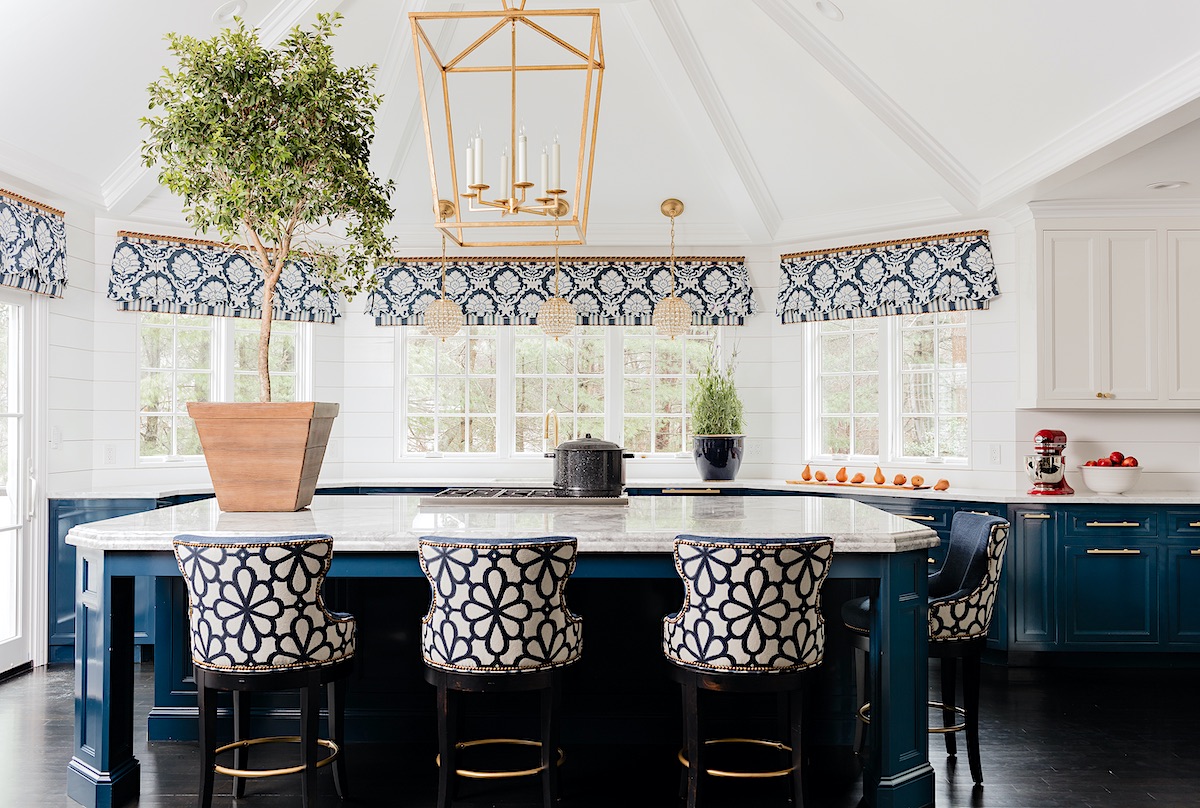
Christa O'Leary takes advantage of an oversized island and soaring ceiling to hang a giant brass lantern in this kitchen. Lighting by Visual Comfort. Photo by Michael J. Lee
Christa O'Leary takes advantage of an oversized island and soaring ceiling to hang a giant brass lantern in this kitchen. Lighting by Visual Comfort.
Most designers regard scale as paramount—“dinkiness” should be kept at bay. As Boston designer Robin Gannon says, “You want to scale your lights appropriately. Too many people use ceiling lights and fixture lights that are far too small for the space. I tend to go bigger. If I have to default one way or another, I always default bigger.”
Adds Atlanta designer Jessica Davis of Atelier Davis, “I love playing with scale on the decorative lighting with a really large oversized lantern over an island or a series of very slim pendants that are super petite. I’m really excited about a fixture we are currently doing on a kitchen island that is a counter-mounted, super slim library light in brass.”
Layton Campbell says, “Pay attention to scale in lighting your kitchen. I have seen many mistakes made by using the wrong size pendants over an island or sconces flanking an area. Statement pieces are great, but if it’s all you see then you’re going to overdo it and no one will notice anything else. Remember, good design is like a symphony—all the instruments must blend together to make beautiful music.”
Washington, D.C., designer Andrea Houck agrees. “The pendants over the island provide another layer of task lighting. A popular trend now is to hang dramatically oversized pendants above the island. It’s important, however, to consider the ceiling height, island dimensions, and footprint of the space before committing to this popular look.”
FLOORPLAN CONSIDERATIONS
Designers also take into account the adjoining spaces, especially a breakfast area. As designer Ashley Hanley of Richmond, Virginia explains: “Most of my projects typically have a breakfast room that opens into the kitchen and I like to make sure that the chandelier or fixture over the breakfast table coordinates but does not match the island pendant lights. I tend to gravitate towards classic lighting with something a little more fun and unexpected over the breakfast table. Lanterns and bell jars make beautiful statements over an island that will age well over time,” she says.

Photos by Kip Dawkins
“In this particular project, I did softer drum shade pendants over the island and went with a more whimsical lantern over the breakfast table (see below). I love the contrast of the softness of the pendant lights against the harder kitchen surfaces and the more open lantern with the soft treatments in the breakfast nook,” says Ashley Hanley. Lighting by Visual Comfort.

Photos by Kip Dawkins
“In this particular project, I did softer drum shade pendants over the island and went with a more whimsical lantern over the breakfast table. I love the contrast of the softness of the pendant lights against the harder kitchen surfaces and the more open lantern with the soft treatments in the breakfast nook.” Some designers match the fixtures, it really just depends on your personal preference.
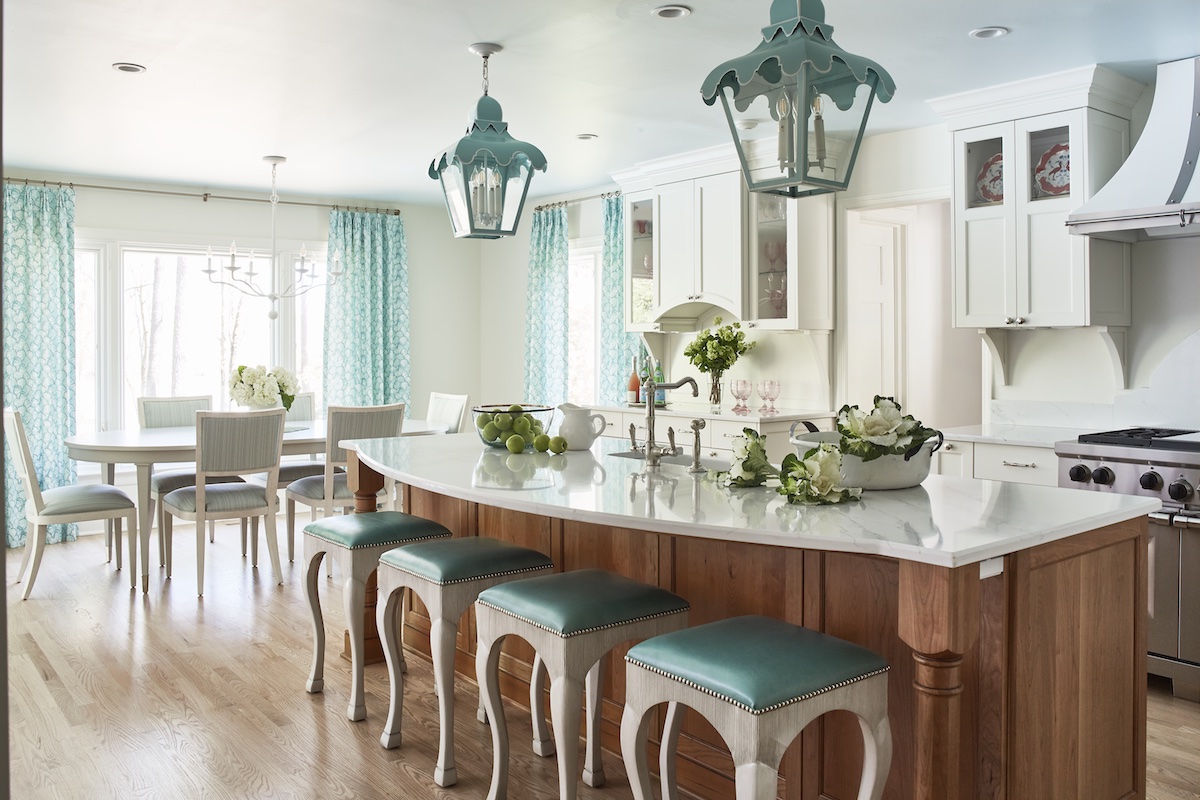
Photo by Kip Dawkins
Richmond designer Sarah Hillery brought color to the kitchen with aqua pagoda-style pendants which play off the barstools and window panels, She chose a more subtle white chandelier for the breakfast area that's distinct and complementary. Lighting: lanterns by JM Piers, chandelier by Feiss.
STYLES AND FINISHES
Should you mix or match? Birmingham, Alabama designer Ellie Christopher says: “Don’t feel the need to be matchy matchy. It can feel stiff and showroom-like. Mixing metals can feel very layered and intentional when done the right way. It’s all about balance and proportions. When it comes to mixing styles try to pair something clean with something ornamented or crusty, old and new, high and low.”

Photo by Blu Lemonade Photography
Christa O'Leary chose a woven, rattan statement piece to hang over the breakfast table, a contrast to the more traditional metal lanterns over the island.
Adds Lexington, Kentucky designer Isabel Ladd: “For pendants or chandeliers over islands, I prefer either super awesome, statement lights that really define a space, or antique lights that are in high contrast to the ‘new’ kitchen look,” she says. “To me, it’s all about contrast. For sconces, I prefer ‘Library Lights’ because I love the look of lights that don’t scream ‘kitchen lights!’ and look like they could belong in other rooms of the house. This gives a sense of flow between rooms. For recessed lights, I like small architectural lights — nothing larger than a 4″. But my personal favorite touch is anything oversized, like this rattan, organic light over a kitchen table.” (see image below)
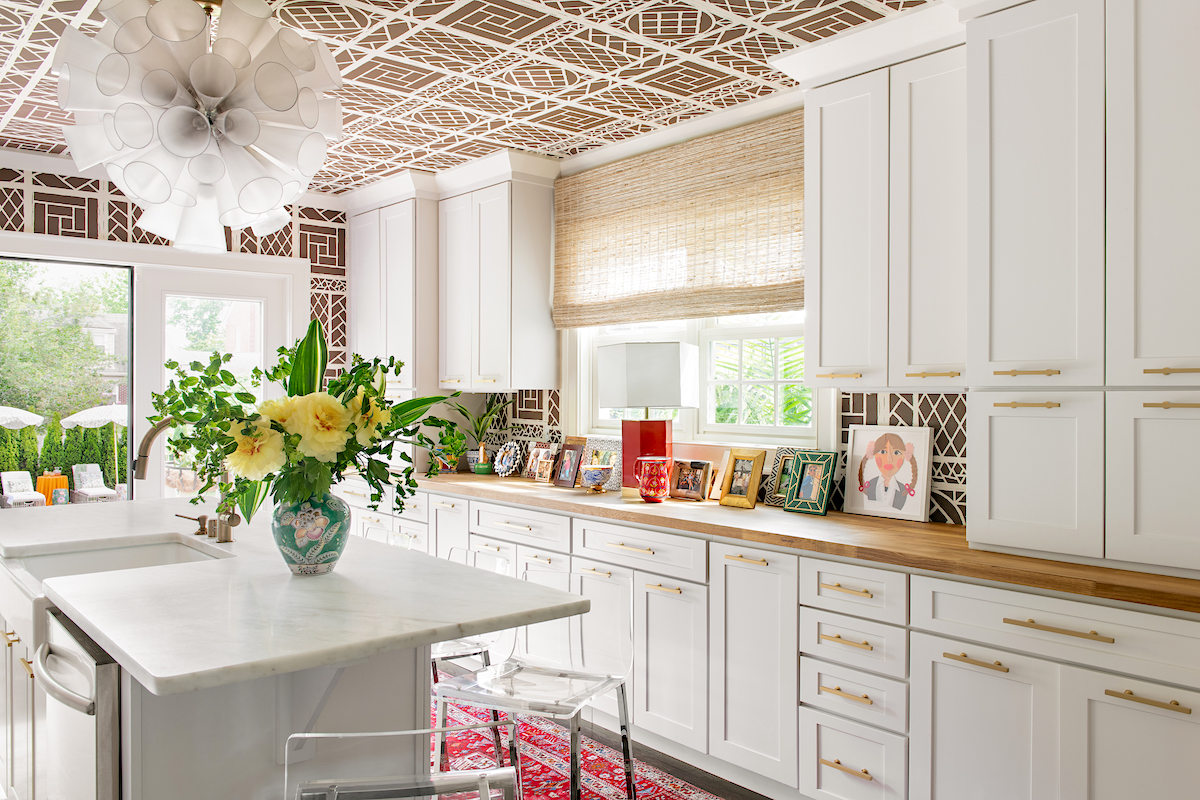
Photo by Katie Charlotte
Lexington based Isabel Ladd likes to use fixtures that don’t scream kitchen and could be found in other rooms in the house like this cool, bold chandelier. Lighting: Oly Studio.

Photo by Katie Charlotte
For a kitchen-adjoining breakfast space Isabel Ladd went big with a rattan pendant over the seating area. Lighting by Currey & Company.
Dallas designer Denise McGaha is clearly in the mix camp as she explains: “I work hard never to match anything. The scale of the piece is more important than matching and I often work to not match finishes on decorative lighting to kitchen finishes in order to make it feel more like a decorative item and not part of the kitchen finishes.”
Los Angeles designer Barclay Butera likes a more seamless look. “I am not a big mix-it-up kind of guy; I like continuity of design and things that make sense together. For instance, I would never use rustic iron fixtures in a loft or contemporary kitchen’” he says. “I look at a project as being a cohesive story that flows seamlessly from room to room. I also think that when I see a surprise or kooky fixture in any room, it’s a bit gimmicky, not my style.”

Photo by Nathan Schroeder
Los Angeles based designer Barclay Butera prefers consistent finishes in a kitchen. In this one, the hardware and plumbing fixtures are chrome paired with chrome and glass pendants. Lighting by Visual Comfort.
Melanie Gowen has this tip: “Living finishes such as unlacquered brass, oil rubbed bronze, or polished nickel will age with time, so they are the best choice for creating a sense of history and age in a kitchen. Polished chrome and black or brushed nickel/gold will remain the same over time, so they are the best choice if you want to maintain a look of newness and perfection.”
New Orleans designer Hattie Sparks opts for classic over trendy for the kitchen and sums up with, “Kitchens aren’t really rooms that get re-vamped often, so you want to be sure you’re choosing fixtures that you won’t get tired of easily—high quality materials in classic silhouettes are good choices.”
ANTIQUE AND VINTAGE KITCHEN LIGHTING
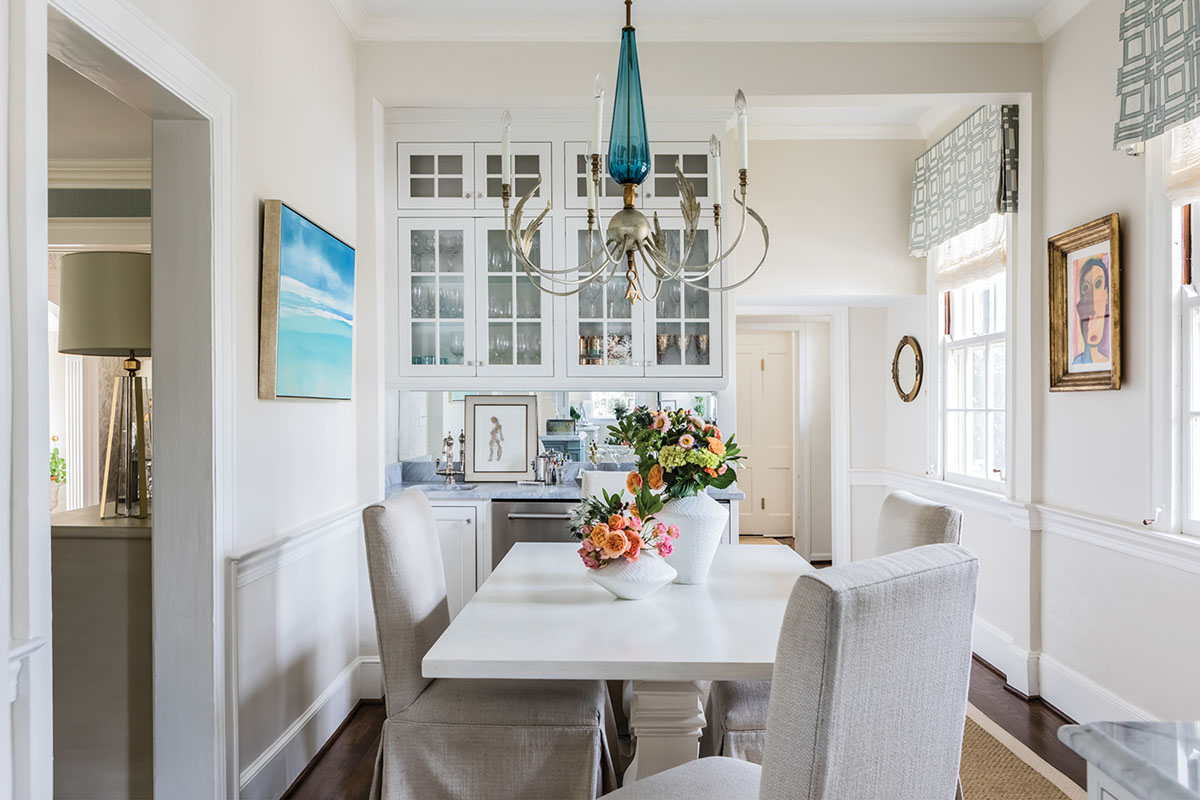
Photo by Catherine Nguyen
Raleigh, North Carolina designer Martha Schneider used a vintage glass chandelier in silver and gold leaf by Louise Gaskill in the breakfast area adjoining her kitchen.
Many designers like to incorporate lighting for the kitchen that has patina and is unique to give some added flair in the space. Belmont, North Carolina designer Kathy Smith notes: “I love to use antique chandeliers in a kitchen and adjoining breakfast room. They have such individual character, but you never want to block the view no matter what you choose.” Adds Dallas, Texas designer Josh Pickering: “I think found/antique lighting is always welcome in a kitchen. It’s a room that can be austere and full of technology. So, a touch of charm or whimsy goes a long way.”
PRACTICAL CONCERNS FOR KITCHEN LIGHTING
Greensboro, North Carolina designer Kara Cox says: “We like to use fixtures that are easy to clean in a kitchen because of the nature of cooking and messy cooks! We prefer two large pendants over an island to three smaller ones, or even one single large fixture over an island to keep the space visually clean,” she says. “We often look for pendants with white glass and covered bulbs. Clear glass can really get dirty quickly with splatter from sinks and cooktops. We try to avoid lighting with fabric shades for the same reason if the client is a true home-chef. We do love to incorporate color and pattern by using fabric shades on accent sconces in auxiliary spaces in kitchens like serving bars or a butler’s pantry.”
CUSTOM LIGHTING
Many designers like to include custom fixtures in a project for a unique flair as Richmond, Virginia designer Sara Hillery does. “Invest in good lighting for focal points and statement locations in each space. One-of-a-kind or custom pieces will make the room!” The designer also likes to include custom fabric pendant or lamp shades. “I use custom lampshades to coordinate with the design of the space. I use them on lamps on chandeliers, sconces, and lamps in the kitchen.”
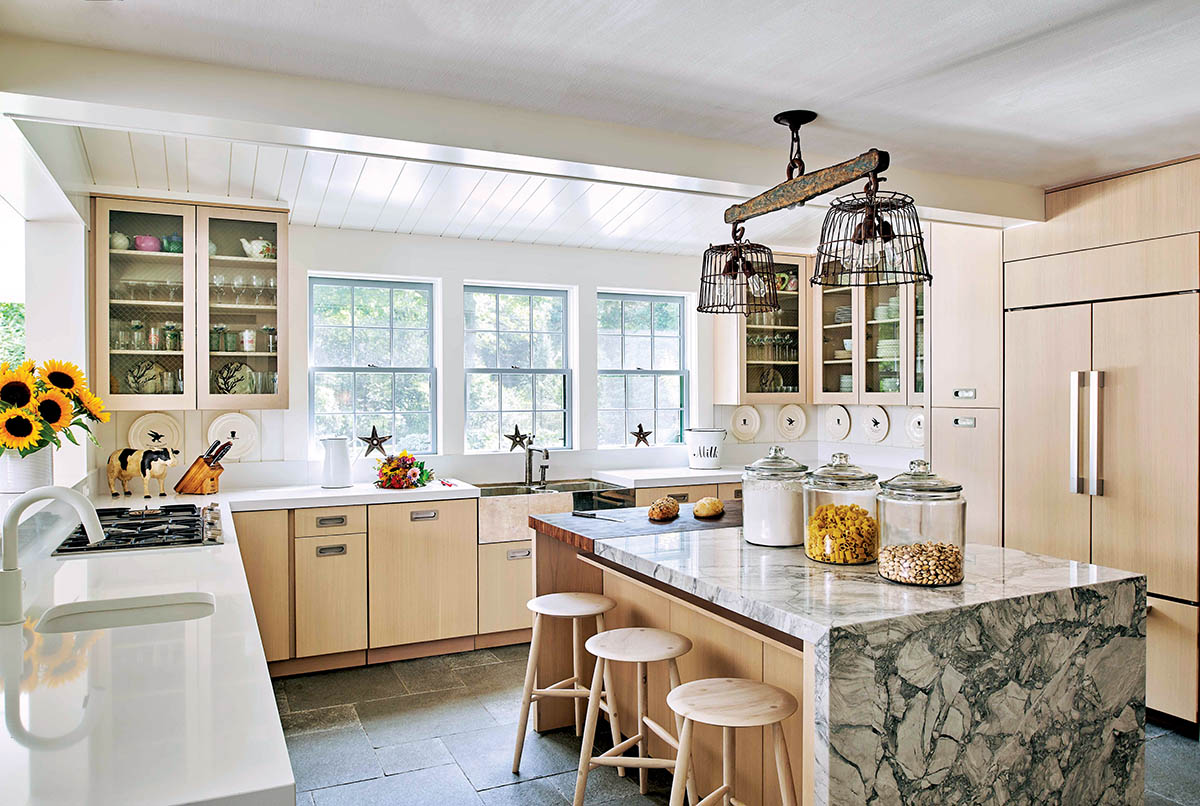
Photo by Michael Mundy
This house addition included a highly functional open kitchen. The light fixture is made from vintage egg baskets hung with a yoke sourced from the local farm museum. “It’s wonderful what you can create with found objects,” says designer Phillip Thomas.
Dallas designer Denise McGaha adds, “I like to create custom designed pieces for our projects when I need to create large scaled pieces for voluminous rooms. Custom designs can also be a great way to find a finish that isn’t off the shelf. Whether it’s paint, lacquer, or metal shades, making custom lighting is a result of not finding what I need in the market. While it may sound like a large investment, it often is less than you would imagine.”
THE RECESSED LIGHTING CONTROVERSY

Photo by Marco Ricca
Recessed lighting can be discreet when they are flush to the ceiling and put on dimmers. Lisa Frantz used a bold brass light square fixture over the island that complements the range hood. Lighting by Urban Electric.
A lot of designers avoid canned/recessed lights and look for alternatives. Birmingham, Alabam designer Ellie Christopher explains: “The new trend seems to be the can lights that are seamless with the Sheetrock. They’re visually appealing to a designer because they tend to disappear, but I also love the concept of multiple smaller pendants instead of can lights,” she says. “LED strip light underneath upper cabinets for additional prep-lighting is popular, but don’t add too much or your countertops can look like a landing strip!”
Adds Dallas designer Josh Pickering: “As everywhere else, I try to avoid using too many recessed fixtures, and try to incorporate hanging lights and sconces, but one faux pas if you do use recessed lights is putting them in the wrong place,” he says. “Since it is a workspace, you need to consider where you will be standing, and that there is a light source in front of you. There is nothing worse than a can light right behind your head and you have to cook in your own shadow.”
New Orleans and New York designers Courtney Coleman and Bill Brockschmidt make exceptions in this hard-working space. “Kitchens are one of the only rooms where we embrace recessed ceiling lights and we typically use sleek fixtures with plastered-in trims so that they are as unobtrusive as possible. Since these recessed fixtures provide an even wash of light in the room, any decorative fixtures can be employed more for sparkle and style.”
DIMMERS EVERYWHERE
Every designer we interviewed cited dimmers as essential in a kitchen on every possible fixture to allow control of the mood and needs of the user.
As West Yarmouth, Massachusetts designer Angela Hamwey explains: “The overarching advice is to install dimmers and switches intentionally as they play an important role in an effective lighting scheme. When set up correctly, they’ll allow you to control which lights are on and can set the mood accordingly,” she says. “Since the kitchen is a multi-functional space used for both cooking and entertaining, the lighting should be intentional. We recommend task lighting for food preparation areas and decorative or accent lighting for entertainment purposes. Instead of relying on recessed lighting, consider directional lighting or wall-mounted angled lamps to highlight specific areas within the kitchen.”
By Alice Welsh Doyle
MORE FROM THE DESIGN EXPERTS IN THIS FEATURE
Angela Hamwey of Mackenzie & Co. – Instagram: @mackenziestudio
Ashley Hanley of Ashley Hanley – Instagram: @ashleybhanley
Andrea Houck of A. Houck Designs – Instagram: @ahouckdesigns ; “Southern Hospitality on Capital Hill”
Anna Still and Marguerite Johnson of Still Johnson – Instagram: @still.johnson
Barclay Butera of Barclay Butera Interiors – Instagram: @barclaybutera ; “Revival at L’Auberge Del Mar”
Beth Meyer of Beth Meyer Design – Instagram: @bethmeyerdesign
Bethany Adams of Bethany Adams Interiors – Instagram: @bethany.adams.interiors
Christa O’Leary of Home in Harmony – Instagram: @homeinharmonydesigns
Courtney Coleman and Bill Brockschmidt of Brockschmidt & Coleman – Instagram: @brockschmidtandcoleman
Denise McGaha of Denise McGaha Interiors – Instagram: @denisemcgaha ; “Design Q & A with Denise McGaha”
Ellie Christopher of Ellie Christopher Interiors – Instagram: @ellie_christopher
Hattie Sparks of Hattie Sparks Interior Design Studio – Instagram: @hattiesparks
Isabel Ladd of Isabel Ladd Interiors – Instagram: @isabel_ladd_interiors
Jessica Davis of Atelier Davis – Instagram: @atelier_davis
Josh Pickering of Pickering House Interiors – Instagram: @joshuapickering
Kara Cox of Kara Cox Interiors – Instagram: @karacoxinteriors ; “Kara Cox Creates a Place of Peace”
Kathy Smith of Kathy Smith Interiors – Instagram: @kathysmithinteriors
Layton Campbell of J Layton Interiors – Instagram: @jlaytoninteriors
Lisa Davenport of LDD Interiors – Instagram: @lddinteriors
Lisa Frantz of Lisa Frantz Interiors – Instagram: @lisafrantzinteriors
Melanie Gowen of Melanie Gowen Design – Instagram: @melaniegowendesign
Phillip Thomas of Phillip Thomas Inc. – Instagram: @phillipthomasinteriors ; “Living in a Jewel Box”
Robin Gannon of Robin Gannon Interiors – Instagram: @robingannoninteriors
Sara Hillery of Sara Hillery Interiors – Instagram: @sarahilleryinteriordesign
Trish Sheats of Trish Sheats Interior Design – Instagram: @trishsheatsid ; “Texas Sophisticate”




